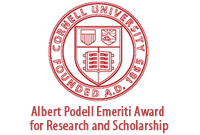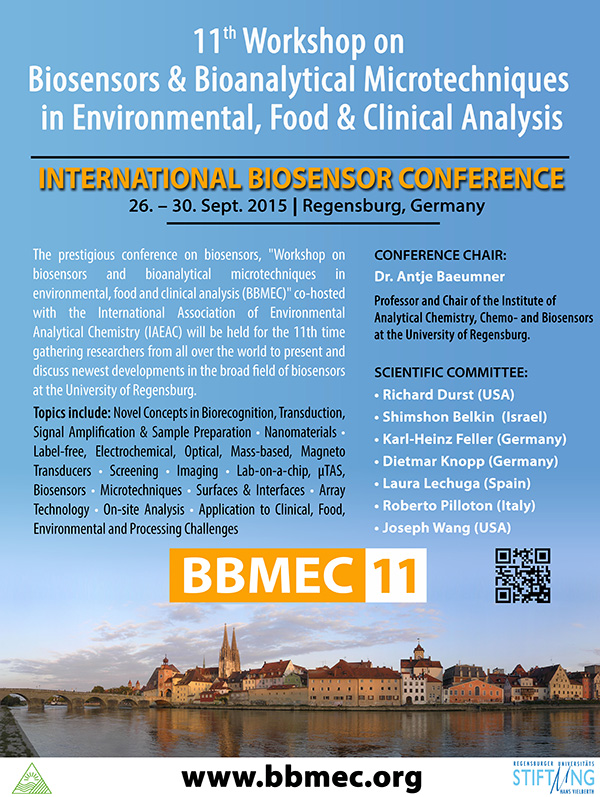This conference will bring together world-renown researchers presenting their most current work relating to bioanalytical sensors. Innovation will be a red thread throughout the conference program. In good tradition with conferences such as previous BBMEC and the US-based Gordon Research Conference on Bioanalytical Sensors the participant size will be limited so that conferee networking and discussion sessions can become most productive and interesting.
Key features of the conference are:
- Keynote and half of all oral presentations are held by invited speakers
- Presentation of unpublished data
- Ample discussion time after each presentation
- High prominence and importance of the poster session
- Pre-conference graduate student/postdoc symposium
The main conference program will start with a keynote presentation for all participants on Sunday evening. Prior to the opening, a pre-conference will be organized targeting graduate students and postdocs (no senior researchers are “allowed”). Here, several students will be selected from submitted poster abstracts to give an oral presentation. Discussion, networking and poster session will be organized starting Saturday evening and last until the opening of the main conference. This concept has been tried previously successfully at Gordon Research Conferences and found to be a highly effective strategy to provide young researchers with networking opportunities, encourage participation in discussion at the pre- and main-conferences, and also provide students with more opportunities for oral presentation. Graduate students and postdocs are therefore encouraged to register for the pre-conference in addition to the main conference.
| M A I N - C O N F E R E N C E Innovation for Bioanalytical Sensors and their Applications |
|
| Sunday 27/9/2015 | |
| 3 p.m. | Registration opens |
| 5 p.m. | Welcome Address by conference chair Antje J. Baeumner |
| 5:10 p.m. | Keynote Speaker, Joseph Wang, UC San Diego, USA Nanomotor-based biosensing: Moving the receptor around the sampler |
| 6 p.m. | Lisa Hall, University of Cambridge, UK Bioinspired semiconducting nanoparticles |
| 6:45 p.m. | Welcome mixer with food, drinks, time for networking, first peeks at posters and discussion with exhibitors |
| 9 p.m. | End of conference day. |
| Monday 28/9/2015 | |
| 9 a.m. | Andrew Ellington, University of Texas, Austin, USA Signaling: creating something from nothing or why equilibrium is overrated |
| 9:45 a.m. | Laura Lechuga, ICN2, CSIC, Barcelona, Spain Nanophotonic lab-on-a-chip biosensors for the next diagnostics generation |
| 10:30 a.m. | Shimshon Belkin, Hebrew University (HUJI), Jerusalem, Israel Microbial biosensors for the remote detection of buried landmines |
| 11:15 a.m. | Jiri Homola, The Czech Academy of Sciences, Prague, Czech Republic Plasmonic affinity biosensors |
| 12 p.m. | Lunch break |
| 1 p.m. | Poster session A (coffee available) |
| 2 p.m. | Poster session B (coffee available) |
| 3 p.m. | Ute Resch-Genger, Fed. Inst. of Materials Research & Testing, Berlin, Germany Methods for the determination of the optical properties and the surface chemistry of fluorescent particles |
| 3:40 p.m. | Man Bock Gu, Korea University, Seoul, Rep. of Korea Dual aptamers and flexible aptamers-based biosensors |
| 4:20 p.m. | Jenny Emneus, Technical University of Denmark, Copenhagen, Denmark Microfluidic electrochemical arrays for biosensing applications |
| 5 p.m. | Petra Dittrich, ETH Zurich, Switzerland Cell-derived vesicles on microfluidic platforms for pharmaceutical and diagnostic applications |
| 5:40 p.m. | Petr Skladal, CEITEC, Masaryk University, Brno, Czech Republic Biosensing with AFM |
| 6.10 p.m. | End of conference day. Possibility to participate in guided tour of Regensburg (registration required) |
| Tuesday 29/9/2015 | |
| 9 a.m. | Dieter Braun, Ludwig-Maximilian University, Munich, Germany Novel sample preparation strategies for bioanalytical sensors |
| 9:45 a.m. | Sam Nugen, University of Massachusetts, Amherst, MA, USA Engineering bacteriophages for rapid food and environmental bacteria sensing |
| 10:30 a.m. | Margaret Frey, Cornell University, Ithaca, NY, USA Electrospun nanofibers for biosensors |
| 11:15 a.m. | Ursula Sauer, AIT Institute of Technology, Austria Making protein biochips more attractive for real-life applications |
| 11:45 a.m. | Katie Edwards, Cornell University, Ithaca, NY, USA Liposomes and magnetic attraction |
| 12:15 p.m. | Lunch break |
| 1 p.m. | Poster session A (coffee available) |
| 2 p.m. | Poster session B (coffee available) |
| 3 p.m. | Christoph Kutter, EMFT, Fraunhofer Society, Munich, Germany Sensors for the internet of things |
| 3:40 p.m. | Yoshinobu Baba, Nagoya University, Japan Nanobiodevices for cancer diagnosis, cancer therapy, and iPS cell-based regenerative medicine |
| 4:20 p.m. | Karl-Heinz Feller, Ernst-Abbe University of Applied Sciences Jena, Germany A cell-based lab-on-a-chip as an alternative method for skin irradiation tests |
| 5:00 p.m. | Markus Fischer, University of Hamburg, Germany Just in Time-Selection: A semiautomated two-step method for in vitro selection of DNA aptamers |
| 5:40 p.m. | Michael Seidel, TU Munich, Germany Rapid detection of pathogens by flow-based chemiluminescence microarrays |
| 6:10 p.m. | Roberto Pilloton, CNR, Roma, Italy Information on the 12th BBMEC in 2017 |
| 6:20 p.m. | End of conference day. |
| 7:30 p.m. | Conference Dinner in the Salzstadl at the Steinerne Brücke, old town Regensburg |
| Wednesday 30/9/2015 | |
| 9 a.m. | Andrea Robitzki, Leipzig University, Germany Bioelectronics high-content screening of chemotherapeutics in tumor micro-fragments in real-time regarding chemosensitivity |
| 9:40 a.m. | Dianping Tang, Fuzhou University, PR China Immunosensors and immunoassays exploiting nanostructure labels |
| 10:20 a.m. | Suna Timur, Ege University, Izmir, Turkey Design of novel surfaces for selective cell adhesion and biosensing |
| 11 a.m. | Julia Perez-Prieto, University of Valencia, Spain Acid resistant upconverting nanoparticles |
| Promising Young Scientist Talks selected from posters | |
| 11:40 a.m. | t.b.a. |
| 11:55 a.m. | t.b.a. |
| 12:10 p.m. | t.b.a. |
| 12:25 p.m. | Poster Award Ceremony |
| 12:45 p.m. | Lunch and end of the Conference. |
| 1 p.m. | Featured talk for BBMEC and COST Workshop participants: Sam Lawrence, CytoViva Characterizing Upconverting Nanoparticles with Hyperspectral Microscopy |



